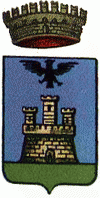Calatafimi-Segesta
 |
The full name of the municipality was created in 1997 and is meant to highlight the presence within its territory of the 5th century BC Doric temple of Segesta, widely regarded as one of the most intact of its type. Adjoining the temple, on a nearby hilltop, there is a 2nd-century Roman amphitheater.
The town developed during the age of the Muslim emirate of Sicily, when it was known as Qalʿat Fīmī (قلعة فيمي), referring to the defensive castle overlooking the town, now partially restored from ruins. One hypothesis for the castle's name derives it from Castrum Phimes – a stronghold protecting the territory of a Roman period nobleman mentioned by Cicero, Diocles Phimes. Another hypothesis derives it from "Castle of Euphemius", possibly referring to the 5th-century Byzantine patriarch by that name or, more likely, to the 9th-century Byzantine commander, who brought Muslim troops to Sicily in 827, helping begin the Muslim conquest of Sicily.
Calatafimi's part of Sicily was one of the first to be occupied by the Aghlabids from Ifriqiya in their conquest of the island, and was one of the last centres of Islamic culture after the end of the Norman rule. The excavations near Segesta have revealed a 12th-century Islamic necropolis and mosque. There are also references to an Islamic-period town called Calathamet (Qalʿat al-Ḥamma, قلعة الحمّة), on the border of the territories of Calatafimi and Castellammare del Golfo, possibly equating the modern Terme Segestane.
From 1336 until 1860, Calatafimi was a feudal territory under Habsburg and Spanish nobles, despite three attempts to regain an independent status (in 1399, 1412 and 1802).
It was on a hill near Calatafimi, called Pianto Romano, that, in 1860, Giuseppe Garibaldi and his Mille first encountered the troops of the Bourbons on a battlefield (see the Battle of Calatafimi). This was the first significant battle for the Italian unification (or Risorgimento) and it was in this battle that Garibaldi was said to have uttered the famous battle cry: "Here we make Italy, or we die" (in Italian "Qui si fa l'Italia, o si muore"). A memorial, in the form of large stone obelisk containing an ossuary of the remains of those fallen in the battle, currently marks the hilltop.
In his later life, the 19th-century English novelist Samuel Butler made annual trips to Calatafimi, and a street of the town was named after him. Summer theatres is held in the Roman amphitheatre at Segesta every other year. A new archaeological museum is being created that will show findings from the Segesta archaeological excavations.
Map - Calatafimi-Segesta
Map
Country - Italy
 |
 |
| Flag of Italy | |
Italy was the native place of many civilizations such as the Italic peoples and the Etruscans, while due to its central geographic location in Southern Europe and the Mediterranean, the country has also historically been home to myriad peoples and cultures, who immigrated to the peninsula throughout history. The Latins, native of central Italy, formed the Roman Kingdom in the 8th century BC, which eventually became a republic with a government of the Senate and the People. The Roman Republic initially conquered and assimilated its neighbours on the Italian peninsula, eventually expanding and conquering a large part of Europe, North Africa and Western Asia. By the first century BC, the Roman Empire emerged as the dominant power in the Mediterranean Basin and became a leading cultural, political and religious centre, inaugurating the Pax Romana, a period of more than 200 years during which Italy's law, technology, economy, art, and literature developed.
Currency / Language
| ISO | Currency | Symbol | Significant figures |
|---|---|---|---|
| EUR | Euro | € | 2 |
| ISO | Language |
|---|---|
| CA | Catalan language |
| CO | Corsican language |
| FR | French language |
| DE | German language |
| IT | Italian language |
| SC | Sardinian language |
| SL | Slovene language |















